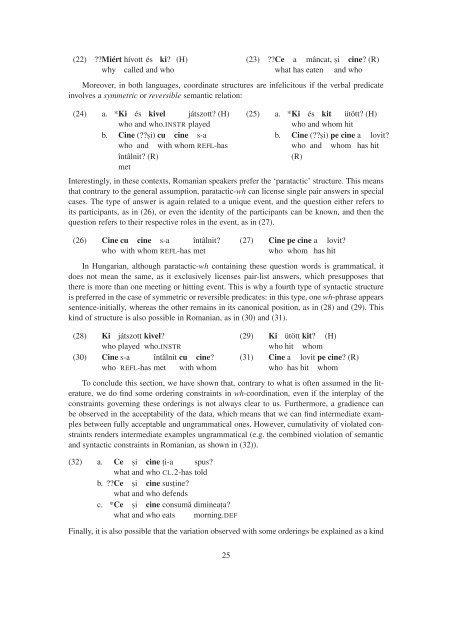Empirical Issues in Syntax and Semantics 9 (EISS 9 ... - CSSP - CNRS
Empirical Issues in Syntax and Semantics 9 (EISS 9 ... - CSSP - CNRS
Empirical Issues in Syntax and Semantics 9 (EISS 9 ... - CSSP - CNRS
Create successful ePaper yourself
Turn your PDF publications into a flip-book with our unique Google optimized e-Paper software.
(22) ??Miért hívott és ki? (H) (23) ??Ce a mâncat, și c<strong>in</strong>e? (R)<br />
why called <strong>and</strong> who<br />
what has eaten <strong>and</strong> who<br />
Moreover, <strong>in</strong> both languages, coord<strong>in</strong>ate structures are <strong>in</strong>felicitous if the verbal predicate<br />
<strong>in</strong>volves a symmetric or reversible semantic relation:<br />
(24) a. *Ki és kivel<br />
who <strong>and</strong><br />
b. C<strong>in</strong>e (??și) cu<br />
who <strong>and</strong> with<br />
întâlnit? (R)<br />
met<br />
who.INSTR<br />
c<strong>in</strong>e<br />
whom<br />
játszott? (H)<br />
played<br />
s-a<br />
REFL-has<br />
(25) a. *Ki és kit ütött? (H)<br />
who <strong>and</strong> whom hit<br />
b. C<strong>in</strong>e (??și) pe c<strong>in</strong>e a lovit?<br />
who <strong>and</strong> whom has hit<br />
(R)<br />
Interest<strong>in</strong>gly, <strong>in</strong> these contexts, Romanian speakers prefer the ‘paratactic’ structure. This means<br />
that contrary to the general assumption, paratactic-wh can license s<strong>in</strong>gle pair answers <strong>in</strong> special<br />
cases. The type of answer is aga<strong>in</strong> related to a unique event, <strong>and</strong> the question either refers to<br />
its participants, as <strong>in</strong> (26), or even the identity of the participants can be known, <strong>and</strong> then the<br />
question refers to their respective roles <strong>in</strong> the event, as <strong>in</strong> (27).<br />
(26) C<strong>in</strong>e<br />
who<br />
cu c<strong>in</strong>e s-a întâlnit?<br />
with whom REFL-has met<br />
(27) C<strong>in</strong>e<br />
who<br />
pe c<strong>in</strong>e<br />
whom<br />
a lovit?<br />
has hit<br />
In Hungarian, although paratactic-wh conta<strong>in</strong><strong>in</strong>g these question words is grammatical, it<br />
does not mean the same, as it exclusively licenses pair-list answers, which presupposes that<br />
there is more than one meet<strong>in</strong>g or hitt<strong>in</strong>g event. This is why a fourth type of syntactic structure<br />
is preferred <strong>in</strong> the case of symmetric or reversible predicates: <strong>in</strong> this type, one wh-phrase appears<br />
sentence-<strong>in</strong>itially, whereas the other rema<strong>in</strong>s <strong>in</strong> its canonical position, as <strong>in</strong> (28) <strong>and</strong> (29). This<br />
k<strong>in</strong>d of structure is also possible <strong>in</strong> Romanian, as <strong>in</strong> (30) <strong>and</strong> (31).<br />
(28) Ki játszott kivel?<br />
who played<br />
(30) C<strong>in</strong>e s-a<br />
who REFL-has<br />
who.INSTR<br />
întâlnit<br />
met<br />
cu<br />
with<br />
c<strong>in</strong>e?<br />
whom<br />
(29) Ki ütött kit? (H)<br />
who hit whom<br />
(31) C<strong>in</strong>e a lovit pe c<strong>in</strong>e?<br />
who has hit whom<br />
To conclude this section, we have shown that, contrary to what is often assumed <strong>in</strong> the literature,<br />
we do f<strong>in</strong>d some order<strong>in</strong>g constra<strong>in</strong>ts <strong>in</strong> wh-coord<strong>in</strong>ation, even if the <strong>in</strong>terplay of the<br />
constra<strong>in</strong>ts govern<strong>in</strong>g these order<strong>in</strong>gs is not always clear to us. Furthermore, a gradience can<br />
be observed <strong>in</strong> the acceptability of the data, which means that we can f<strong>in</strong>d <strong>in</strong>termediate examples<br />
between fully acceptable <strong>and</strong> ungrammatical ones. However, cumulativity of violated constra<strong>in</strong>ts<br />
renders <strong>in</strong>termediate examples ungrammatical (e.g. the comb<strong>in</strong>ed violation of semantic<br />
<strong>and</strong> syntactic constra<strong>in</strong>ts <strong>in</strong> Romanian, as shown <strong>in</strong> (32)).<br />
(32) a. Ce și c<strong>in</strong>e ți-a spus?<br />
what <strong>and</strong> who CL.2-has told<br />
b. ??Ce și c<strong>in</strong>e susț<strong>in</strong>e?<br />
what <strong>and</strong> who defends<br />
c. *Ce<br />
what<br />
și<br />
<strong>and</strong><br />
c<strong>in</strong>e<br />
who<br />
consumă<br />
eats<br />
dim<strong>in</strong>eața?<br />
morn<strong>in</strong>g.DEF<br />
F<strong>in</strong>ally, it is also possible that the variation observed with some order<strong>in</strong>gs be expla<strong>in</strong>ed as a k<strong>in</strong>d<br />
(R)<br />
25











